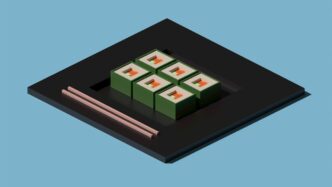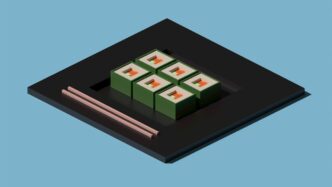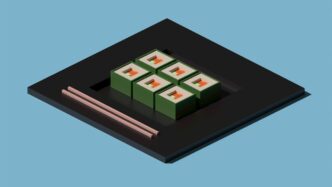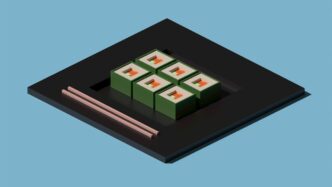Thinking about the google quantum computer cost can feel a bit like trying to guess the price of a spaceship – it’s complex, cutting-edge, and not something you’ll find on a shelf. Google’s been pouring a lot of money and brainpower into this field, aiming for breakthroughs that could change industries. We’ve seen some impressive steps, like the Sycamore processor and the newer Willow chip, which hint at what’s possible. But what does all this mean for the actual cost, and when might we see practical applications that justify the investment? Let’s break it down.
Key Takeaways
- Google is investing heavily, potentially billions, over the next decade in quantum computing, with a long-term goal of building a million-qubit system.
- Early commercial quantum computers, like those from D-Wave, were priced in the millions, though smaller desktop versions have appeared at lower price points.
- Google’s Sycamore processor and the Willow chip represent significant milestones, particularly in error correction, which is vital for making quantum computers reliable and useful.
- The core technology relies on qubits, which use superposition to process information far beyond the capabilities of classical bits, but building stable, functional processors is a major challenge.
- Potential future applications in areas like drug discovery, materials science, and artificial intelligence could justify the immense cost and effort involved in developing quantum computing.
Understanding The Google Quantum Computer Cost Landscape
The Ambitious Investment In Quantum Technology
So, let’s talk about the big picture when it comes to quantum computers and, specifically, what Google is putting into this. It’s not exactly pocket change. We’re talking about serious, long-term investment, with billions earmarked over the next decade. Google even built a whole new campus in Santa Barbara just for this quantum AI stuff. Their big goal? A million physical qubits. That’s a huge number, and while it sounds a bit sci-fi, they seem pretty serious about it. They’re not the only ones playing this game, but they’ve definitely been making some noise. Back in 2020, they showed off a 12-qubit chip that could actually simulate a chemical reaction. This wasn’t just a theoretical exercise; it hinted at what these machines could do for real-world problems, like designing better drugs or creating new materials without needing tons of physical prototypes.
Early Commercial Quantum Computer Price Points
When quantum computers first started showing up for sale, they were, predictably, pretty pricey. D-Wave, a Canadian company, was one of the first out of the gate. Back in 2017, they had a machine that cost around $15 million. That’s a number that definitely puts it out of reach for most folks. Even though the technology is still pretty new and not quite ready for everyday tasks, some companies have tried to make them more accessible. There was a startup in China, Spin-Q, that claimed in 2017 to have a desktop quantum computer for less than $5,000. It’s a bit of a mixed bag out there. Even without solving major practical problems yet, some big players have already jumped in. The UK’s Ministry of Defense bought one back in 2017, and big banks like Goldman Sachs and Citigroup have put money into quantum computing companies. It shows there’s a belief in the future, even if the price tags are still pretty wild.
The Evolving Market For Quantum Solutions
The quantum computing scene is changing pretty fast. While Google’s Sycamore processor made waves, there have been other developments that have, let’s say, ‘dullled the shine’ a bit, but the core promise is still there. For instance, some Chinese researchers managed to do a calculation that Google’s machine did, but using a supercomputer that took way less time and power than initially thought. This highlights that proving quantum’s real advantage often needs real-world applications, not just abstract calculations. The Sycamore chip itself, with its 53 working qubits (one of the 54 planned qubits didn’t work out), was a big step, but scientists say we’ll need systems with 100 or even 200 qubits before we can really start tackling practical problems. It’s a journey, and Google is aiming for a working, error-free quantum computer by 2029. The market is still figuring itself out, with different companies exploring various approaches to building these complex machines. It’s a dynamic space, and what seems cutting-edge today might be standard tomorrow.
Google’s Quantum Computing Milestones And Their Cost Implications
Google has been making some serious waves in the quantum computing world, and each big step they take has ripple effects on what these machines might eventually cost. It’s not just about building the hardware; it’s about proving what it can actually do.
The Sycamore Processor And Its Computational Power
Remember the Sycamore processor? That was a pretty big deal back in 2019. Google claimed it performed a calculation in just a few minutes that would take a traditional supercomputer thousands of years. Now, some folks at IBM debated that timeline, saying a supercomputer could do it faster, but the point was made: quantum computers are playing a different game. The Sycamore chip, with its 53 working qubits (one was a bit shy), showed off this incredible speed. While the specific task wasn’t exactly solving world hunger, it was a demonstration of raw computational power. This kind of breakthrough, even if it’s just a calculation spitting out random numbers, hints at the immense potential and, by extension, the complex engineering that goes into making it happen. The cost implications here are tied to the sheer novelty and difficulty of building such a processor.
Advancements In Error Correction With The Willow Chip
One of the biggest headaches in quantum computing is ‘noise’ – basically, errors that mess up calculations. Google’s Willow chip is a step forward because it shows progress in dealing with this. They’ve demonstrated that they can actually reduce errors using a technique called the surface code. This is huge because, for a long time, the error correction process itself could introduce more errors than it fixed. Successfully reducing errors is a key step towards making quantum computers reliable enough for real-world tasks. This doesn’t mean Willow is suddenly outperforming every other chip on qubit lifespan – other systems might be better there. But Google seems to have found a sweet spot where error correction actually helps. This kind of refinement is where a lot of the ongoing investment goes, directly impacting the cost of future, more stable quantum systems.
The Significance Of Verifiable Quantum Advantage
What does ‘quantum advantage’ even mean? It’s the point where a quantum computer can solve a problem that’s practically impossible for even the best classical computers. Google’s Sycamore experiment was an early claim of this. While the specific calculation wasn’t a practical application, it was a signpost. Later, using quantum computers to simulate chemical reactions, like the Hartree-Fock procedure, showed a more tangible benefit. This kind of simulation could help design better drugs or materials. The ability to verify that a quantum computer is actually doing something useful, something beyond what classical machines can handle, is what drives the value proposition. As these machines get better at solving real problems, the investment in quantum technology becomes more justifiable, even if the initial price tags are steep. It’s a journey from theoretical possibility to practical application, and each milestone makes the future cost more understandable.
The Underlying Technology Driving Quantum Computer Costs
So, what makes these quantum machines so expensive and complex? It really boils down to the nuts and bolts – or rather, the qubits and the physics behind them. Unlike the computers we use every day, which rely on bits that are either a 0 or a 1, quantum computers use qubits.
Classical Bits Versus Quantum Qubits
Think of a classical bit like a light switch: it’s either on (1) or off (0). Simple, right? Our laptops and phones are built on billions of these switches. Quantum computers, however, use qubits. These little guys are way more interesting. A qubit can be a 0, a 1, or, and this is the mind-bending part, both 0 and 1 at the same time. This is thanks to a quantum phenomenon called superposition.
The Role Of Superposition In Quantum Computing
Superposition is what gives quantum computers their potential power. Because a qubit can represent multiple states simultaneously, a quantum computer with just a few qubits can explore a vast number of possibilities all at once. Imagine trying to find your way through a maze. A classical computer would try each path one by one. A quantum computer, using superposition, could theoretically explore many paths simultaneously. This is why even a relatively small number of qubits can perform calculations that would take even the most powerful supercomputers an impossibly long time.
Challenges In Building Functional Quantum Processors
Building and controlling these qubits is incredibly difficult and expensive. They are super sensitive to their environment. Even the slightest vibration or temperature fluctuation can mess up the delicate quantum state, leading to errors.
Here are some of the main hurdles:
- Extreme Cold: Many quantum computers need to be cooled to temperatures colder than outer space to work. This requires massive, complex refrigeration systems.
- Isolation: Qubits need to be shielded from any external interference. This means elaborate setups with special materials and vacuum chambers.
- Error Correction: Because qubits are so fragile, errors happen a lot. Developing effective ways to detect and fix these errors without disturbing the computation is a huge ongoing challenge. Google’s recent work with chips like Willow is a big step in this direction, trying to make error correction actually helpful rather than making things worse.
- Scalability: Getting more qubits to work together reliably is tough. Each new qubit added can introduce more complexity and potential for errors. Google’s goal of a million physical qubits is a massive undertaking, and they’re still working on making even hundreds of qubits function well together.
Real-World Applications And The Future Value Of Quantum Computing
So, what’s all the fuss about with quantum computers? It’s not just about faster calculations for the sake of it. The real excitement lies in what these machines could actually do for us. Think about it: problems that would take today’s best supercomputers ages, or are just plain impossible, might become solvable.
Simulating Chemical Reactions For Drug Discovery
One of the most talked-about areas is chemistry. Right now, figuring out how molecules interact is super complex. It’s like trying to predict the weather a year in advance, but for tiny particles. Quantum computers, however, are naturally good at simulating these quantum systems. This means we could get much better at designing new drugs. Instead of endless trial and error in the lab, scientists could simulate how a potential drug would behave with a disease target before even making it. This could speed up the whole process of finding new medicines and make it way more efficient. Google’s team has already shown this is possible, simulating a chemical reaction using a 12-qubit chip, which was a big step towards practical quantum applications.
Advancing Materials Science And Battery Development
It’s not just drugs. The same simulation power can be applied to materials. Imagine creating materials with brand new properties – stronger, lighter, better conductors. This could lead to breakthroughs in everything from more efficient solar panels to batteries that last way longer. We’re talking about a whole new generation of technology built on materials we can’t even dream of today. It’s a bit like having a super-powered design tool for the physical world.
The Intersection Of Quantum Computing And Artificial Intelligence
And then there’s AI. Artificial intelligence systems are hungry for data, and the more data they have, the smarter they can get. Quantum computers could help AI process massive datasets much faster and more accurately than ever before. This could lead to AI that’s not just better at recognizing patterns, but also at making complex decisions. We’re already seeing the beginnings of what’s called ‘quantum AI,’ where these two powerful fields work together. It’s still early days, but the potential for things like smarter financial modeling or more advanced robotics is pretty significant. It’s a bit like giving AI a supercharged brain.
Google’s Long-Term Vision For Quantum Computing
So, what’s the big picture for Google in the quantum world? It’s pretty ambitious, to say the least. They’re not just tinkering; they’re aiming for something massive. The ultimate goal is to build a quantum computer with a staggering one million physical qubits. That’s a huge leap from where we are now, and it shows they’re serious about pushing the boundaries.
The Goal Of A Million Physical Qubits
This isn’t just a number pulled out of thin air. Reaching a million physical qubits is seen as a key step towards building fault-tolerant quantum computers. Think of it like building a city versus just a single house. More qubits mean more power and the potential to tackle much more complex problems that are currently out of reach for even the most powerful supercomputers.
Achieving An Error-Free Quantum Computer By 2029
Google has set a pretty aggressive timeline for itself, aiming to have a functional, error-free quantum computer by 2029. This is a really big deal because quantum computers are notoriously prone to errors. Noise and decoherence can easily mess up calculations. Getting to an "error-free" state means they’ve figured out how to reliably control and correct these errors, which is a major hurdle.
The Next Milestone: Creating Logical Qubits
Beyond just having a lot of physical qubits, the real magic happens when you can create logical qubits. A logical qubit is essentially a more stable, error-corrected qubit made up of many physical qubits. It’s like having a team of workers (physical qubits) all collaborating to perform one perfect task (a logical qubit). This is the path to truly useful quantum computation, where the results are reliable enough for complex scientific and commercial applications. It’s a tough challenge, but it’s the next big frontier Google is focused on.
Factors Influencing The Google Quantum Computer Cost
So, what makes these super-advanced quantum computers so pricey? It’s not just one thing, but a whole bunch of complicated factors that add up. Think of it like building a rocket ship – lots of cutting-edge tech and specialized parts.
The Complexity Of Quantum Hardware Development
Building the actual hardware for a quantum computer is incredibly tough. We’re talking about creating and controlling qubits, which are the quantum version of computer bits. Unlike regular bits that are either a 0 or a 1, qubits can be both at the same time, thanks to something called superposition. This ability is what gives quantum computers their potential power, but it also makes them super sensitive and hard to build.
- Extreme Cooling: Many quantum computers need to be kept at temperatures colder than outer space to work properly. This requires massive, complex refrigeration systems that are expensive to run and maintain.
- Specialized Materials: The materials used to make qubits and other components have to be super pure and precisely engineered. This isn’t like grabbing standard silicon off the shelf.
- Precision Engineering: The physical layout and connections of qubits need to be exact. Even tiny imperfections can mess up calculations.
The Importance Of Error Correction Algorithms
Quantum computers are really prone to errors. Think of it like trying to have a conversation in a hurricane – lots of noise and interference. To get reliable results, scientists need sophisticated error correction techniques. These algorithms are like noise-canceling headphones for the quantum computer, but they add another layer of complexity and cost.
- Overhead: Running error correction often requires using more qubits than are strictly needed for the main calculation. This means you need a bigger, more complex quantum processor to begin with.
- Computational Power: The error correction process itself uses up some of the quantum computer’s processing power, which can slow things down or require even more advanced hardware.
- Algorithm Development: Designing and refining these error correction methods is an ongoing scientific challenge, requiring significant research and development investment.
The Ecosystem Of Commercial Quantum Solutions
Beyond the core hardware, there’s a whole ecosystem that contributes to the cost. This includes the software needed to program these machines, the specialized teams of scientists and engineers required to build and operate them, and the ongoing research to push the boundaries of what’s possible.
- Software Development: Creating user-friendly interfaces and programming languages for quantum computers is a huge undertaking.
- Skilled Workforce: There’s a global shortage of experts who understand quantum mechanics and computer science well enough to work on these systems.
- Research & Development: Google, like other players, is investing billions in R&D to improve qubit stability, increase qubit counts, and explore new quantum algorithms. This continuous innovation is a major driver of the overall cost.
So, What’s the Bottom Line?
Look, figuring out the exact price tag for Google’s quantum computer is still a bit like chasing a ghost. We know they’re spending big, aiming for a million qubits, and have already made some pretty cool progress with chips like Sycamore and Willow. While we’ve seen early commercial quantum computers costing millions, and even some cheaper desktop models popping up, the truly practical, problem-solving machines are still a ways off. Google’s recent work with algorithms like ‘Quantum Echoes’ shows they’re getting closer to making quantum computers do useful things, not just complex math problems. It’s a long road, and they’re aiming for an error-free machine by 2029, but the potential for fields like medicine and materials science is huge. For now, it’s a massive investment in a future technology that’s still very much under construction.
Frequently Asked Questions
How much do quantum computers cost right now?
Quantum computers are still super new and expensive! A few years ago, one company sold a quantum computer for about $15 million. While some smaller companies are trying to make cheaper ones, even under $5,000, these are very basic and can’t do much yet. Most powerful quantum computers are not for sale to the public.
Why are quantum computers so expensive?
Building a quantum computer is incredibly difficult. It requires super-specialized equipment and materials to keep the tiny quantum bits, called qubits, working correctly. Plus, scientists are still figuring out the best ways to build and control them, and fixing errors takes a lot of effort and resources.
What is Google spending on quantum computing?
Google is investing a huge amount of money, planning to spend billions over the next ten years. They’ve even built a special campus just for quantum research. Their big goal is to create a quantum computer with a million qubits, which is a massive number!
What can quantum computers do in the future?
Quantum computers could help us discover new medicines, create amazing new materials for things like batteries, and even make artificial intelligence much smarter. They’re really good at solving super complex problems that regular computers can’t handle.
What is ‘quantum supremacy’?
Quantum supremacy is when a quantum computer can do a specific task that even the most powerful regular supercomputer can’t do, or would take an impossibly long time to finish. Google claimed to achieve this a few years ago with a fast calculation, though others debated how long it would really take a supercomputer.
When will we have useful quantum computers?
Google is aiming to have a working, error-free quantum computer by 2029. However, this is a very tough goal. While they’ve made big steps, like with their Willow chip that helps fix errors, it will still take time before these machines can solve everyday problems reliably.














